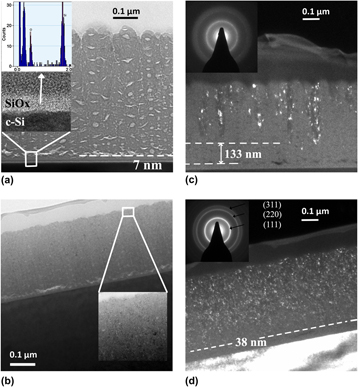Crossref Citations
This article has been cited by the following publications. This list is generated based on data provided by
Crossref.
Samanta, Arup
and
Das, Debajyoti
2012.
Structural investigation of nC-Si/SiOx:H thin films from He diluted (SiH4+CO2) plasma at low temperature.
Applied Surface Science,
Vol. 259,
Issue. ,
p.
477.
Das, Debajyoti
and
Sain, Basudeb
2013.
Electrical transport phenomena prevailing in undoped nc-Si/a-SiNx:H thin films prepared by inductively coupled plasma chemical vapor deposition.
Journal of Applied Physics,
Vol. 114,
Issue. 7,
Raha, Debnath
and
Das, Debajyoti
2013.
Nanocrystalline silicon thin films prepared by low pressure planar inductively coupled plasma.
Applied Surface Science,
Vol. 276,
Issue. ,
p.
249.
Chakraborty, Mahua
Banerjee, Amit
and
Das, Debajyoti
2014.
Spectroscopic studies on nanocrystalline silicon thin films prepared from H2-diluted SiH4-plasma in inductively coupled low pressure RF PECVD.
Physica E: Low-dimensional Systems and Nanostructures,
Vol. 61,
Issue. ,
p.
95.
Kusumastuti, Ella
Siniwi, Widasari Trisna
Mahatmanti, F. Widhi
Jumaeri
Atmaja, Lukman
and
Widiastuti, Nurul
2016.
Modification of chitosan membranes with nanosilica particles as polymer electrolyte membranes.
Vol. 187,
Issue. ,
p.
020037.
Das, Debajyoti
and
Patra, Chandralina
2021.
Wide optical gap B-doped nc-Si thin films with advanced crystallinity and conductivity on transparent flexible substrates for potential low-cost flexible electronics including nc-Si superstrate p–i–n solar cells.
Materials Advances,
Vol. 2,
Issue. 6,
p.
2055.
Shyam, Sukalyan
and
Das, Debajyoti
2021.
Phosphorus-doped nanocrystalline silicon-oxycarbide thin films.
Journal of Alloys and Compounds,
Vol. 876,
Issue. ,
p.
160094.
Saha, Sucharita
and
Das, Debajyoti
2022.
Growth of diamond-like carbon films with significant nanocrystalline phases in a low-pressure high-density CH4 plasma in ICP-CVD: Effect of negative dc substrate bias.
Applied Surface Science,
Vol. 596,
Issue. ,
p.
153638.
Shyam, Sukalyan
and
Das, Debajyoti
2022.
Spectroscopic studies of low-temperature synthesized nanocrystalline silicon oxy-carbide thin films.
Materials Today: Proceedings,
Vol. 62,
Issue. ,
p.
5053.
Paramanik, Brijmohan
and
Das, Debajyoti
2022.
Synthesis of nanocrystalline diamond embedded diamond-like carbon films on untreated glass substrates at low temperature using (C2H2 + H2) gas composition in microwave plasma CVD.
Applied Surface Science,
Vol. 579,
Issue. ,
p.
152132.
Das, Debajyoti
and
Roy, Ajay
2022.
Growth of Nanostructured Diamond Films on Glass Substrates by Low-Temperature Microwave Plasma-Enhanced Chemical Vapor Deposition for Applications in Nanotribology.
ACS Applied Nano Materials,
Vol. 5,
Issue. 3,
p.
3558.
Patra, Chandralina
and
Das, Debajyoti
2022.
Room temperature synthesized highly conducting B-doped nanocrystalline silicon thin films on flexible polymer substrates by ICP-CVD.
Applied Surface Science,
Vol. 583,
Issue. ,
p.
152499.
